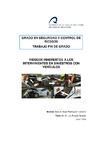Identificador persistente para citar o vincular este elemento:
https://accedacris.ulpgc.es/handle/10553/99570
| Campo DC | Valor | idioma |
|---|---|---|
| dc.contributor.advisor | Álvarez Álvarez, Luis Antonio | es |
| dc.contributor.author | Rodríguez Lendoiro, Manuel Angel | es |
| dc.date.accessioned | 2021-03-11T00:42:14Z | - |
| dc.date.available | 2021-03-11T00:42:14Z | - |
| dc.date.issued | 2019 | - |
| dc.identifier.other | Gestión académica | - |
| dc.identifier.uri | https://accedacris.ulpgc.es/handle/10553/99570 | - |
| dc.description.abstract | En la actualidad, la apariencia exterior de los vehículos es similar a los que tienen una década o más años, pero esto no quiere decir que su anatomía interna sea para nada similar. El presente Trabajo Fin de Grado surge a raíz de la experiencia profesional del autor y su inquietud sobre el avance de los sistemas de seguridad y de las nuevas tecnologías utilizadas en los vehículos actuales (vehículos eléctricos, híbridos…), así como los correspondientes cambios o mejoras que han tenido que surgir de forma paralela en el ámbito del rescate en caso de accidente, con el objetivo de disminuir o anular los nuevos peligros surgidos de cara a los ocupantes y los rescatadores. Todos estos dispositivos si bien generan un estado de seguridad a los ocupantes del vehículo, pueden suponer una para dificultad mayor para los intervienes que acuden al sitio del accidente. Es por ello, que las personas que intervienen en accidentes vehiculares deben tener una buena y actualizada capacitación y conocimiento de todos los adelantos tecnológicos que tienen los vehículos modernos para saber cómo actuar cuando ocurre un accidente. El objetivo final del presente trabajo es que sirva de guía para acompañar y orientar a los profesionales del campo de las emergencias, en especial, a los intervinientes en rescate en accidentes de tráfico. En este trabajo no se desarrollan nuevas técnicas de rescate, lo que se muestra son las técnicas y metodología actuales, empleadas en relación con los peligros surgidos a raíz de las nuevas tecnologías utilizadas en los vehículos modernos. | en_US |
| dc.description.abstract | At present, the exterior appearance of vehicles is similar to those that are a decade or more old, but this does not mean that their internal anatomy is anything similar. That is why the present End of Degree Project arises from the author's professional experience and his concern about the advancement of safety systems and new technologies used in current vehicles (electric vehicles, hybrids ...), as well as the corresponding changes or improvements that have had to arise in parallel in the field of rescue in the event of an accident, with the aim of reducing or canceling the new dangers that have arisen in the face of the occupants and rescuers. All these devices, although they generate a state of safety for the occupants of the vehicle, can be one for greater difficulty for the intervienes that go to the accident site. That is why the people involved in vehicle accidents must have a good and up-to-date training and knowledge of all the technological advances that modern vehicles have to know how to act when an accident occurs. The final objective of this work is to serve as a guide to accompany and guide professionals in the field of emergencies, especially those involved in rescue in traffic accidents. In this work, no new rescue techniques are developed, which is shown by the current techniques and methodology, used in relation to the dangers arising from the new technologies used in modern vehicles. | en_US |
| dc.language | spa | en_US |
| dc.subject | 610901 Prevención de accidentes | en_US |
| dc.title | Riesgos inherentes a los intervinientes en siniestros con vehículos | es |
| dc.type | info:eu-repo/semantics/bachelorThesis | en_US |
| dc.type | BachelorThesis | en_US |
| dc.contributor.departamento | Departamento de Ingeniería Civil | es |
| dc.contributor.facultad | Estructura de Teleformación ULPGC | en_US |
| dc.investigacion | Ciencias Sociales y Jurídicas | en_US |
| dc.type2 | Trabajo final de grado | en_US |
| dc.utils.revision | Sí | en_US |
| dc.identifier.matricula | TFT-53633 | es |
| dc.identifier.ulpgc | Sí | en_US |
| dc.contributor.buulpgc | BU-TEL | es |
| dc.contributor.titulacion | Grado en Seguridad y Control de Riesgos (No Presencial) | es |
| item.fulltext | Con texto completo | - |
| item.grantfulltext | open | - |
| crisitem.advisor.dept | Departamento de Ingeniería Civil | - |
| Colección: | Trabajo final de grado | |
Visitas
209
actualizado el 02-mar-2024
Descargas
747
actualizado el 02-mar-2024
Google ScholarTM
Verifica
Comparte
Exporta metadatos
Los elementos en ULPGC accedaCRIS están protegidos por derechos de autor con todos los derechos reservados, a menos que se indique lo contrario.
